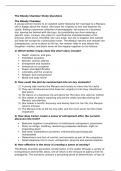The Bloody Chamber Study Questions
The Bloody Chamber
A young woman travels to an isolated castle following her marriage to a Marquis;
she is happy about the match. She loses her virginity to him and explores his
castle, finding a perverse collection of pornography. He leaves on a business
trip, leaving her behind with the keys, but prohibiting her from entering a
specific room. Curious, she enters it, and finds the mutilated bodies of his
previous three wives. Horrified, she runs away, but she is trapped, and nobody
will help her except for a blind piano tuner. The Marquis returns and realises her
transgression; as he is about to kill her, her mother rides in and shoots him.
Daughter, mother, and piano tuner all live happily together on his fortune.
1) Which Gothic tropes does the short story include?
Death, violence, and gore
Forbidden sexuality
Remote, archaic setting
Entrapment and isolation
Innocence vs corruption
Power and objectification
Liminality and the uncanny
Religion and transgression
Blood and body horror
2) How could the plot be summarised into six key moments?
1) A young lady marries the Marquis and travels to move into his castle
2) They are introduced and she loses her virginity to him (key transitional
plot point)
3) He leaves on a business trip and gives her the keys; she calls her mother
4) She settles in before exploring around the castle and discovering the
Marquis’ peculiarities
5) She makes a horrific discovery and keenly fears for her life; the Marquis
returns (climax)
6) The Marquis tries to kill his new wife, and her mum saves her life (most
important)
3) How does Carter create a sense of entrapment after the narrator
discovers the truth?
Bedroom negative connotations of matrimonial entrapment, possession
Music as refuge, soothing, reassuring juxtaposes darkness, night as
impending doom
Bad twist; disobedience punished, intentionally psychologically
manipulated
Determinism and lack of control, and servants as part of the conspiracy
Dead telephone line to mum, entrapment, physical and mental isolation
4) How effective is the story in creating a sense of anxiety?
The Bloody Chamber generates consternation in the reader through a variety of
transgressive and horrific ideas, one of which is the removal of agency from its
protagonist. The narrative contains a prevailing sense of determinism, of loss of
,control, as the fate of the young, innocent protagonist is entirely manipulated by
external, malicious forces. Once she discovers her husband’s true nature, the
curious narrative tone transforms into one of futility and abject desperation. In
retrospect, the Marquis’ conduct towards his new wife seems carefully planned in
order to entrap her into disobedience, and thus justify her punishment. Carter’s
cynicism towards human nature combined with this denial of the conventional
human belief in free will is subversive, undermining one of the most fundamental
human notions of liberty. The narrators’ entrapment does not result from her
status as a victim of circumstance, but it is an inherent element of her being,
adding an additional dimension to her captivity, as she becomes an existential
prisoner to the Marquis. Postmodernism plays a significant role in this motif, as
pre-WWII attitudes were strongly grounded in the idea of divine providence,
acting as reassurance to the virtuous. However, in The Bloody Chamber, there is
no external salvation except what the protagonist and her mother engineer for
themselves. This radical sense of nihilism and abandonment strongly
characterises postmodern literature, and generates a keen sense of anxiety in
readers so keenly acquainted with the notion of free will. Moreover, it is unusual
for the genre, as conventional Gothic protagonists drive the story rather than
experience it: one example of this is Victor Frankenstein, whose creative
freedom becomes his undoing. This deviation from the literary tradition only
serves to highlight the pervasive anxiety and tension stemming from Carter’s
protagonist’s utter lack of agency; until the final moment of liberation from fate
(through the exterior intervention of her mother), she is a mere pawn of the plot.
5) How far do you agree with Carter’s stance on the pure virgin/healing
mother myths?
Carter argues that mythologising and idealising women into the pure
virgin and healing mother archetypes is designed only to give women
‘emotional satisfaction’ and console women about their oppressed status,
‘obscuring the real conditions of life’ (Carter 1978)
o Myth designed by men to force women into conformity if they want
to retain any internal and external value, oppressing them further
rather than comforting them
o Embracing these ideals may deny the less pleasant realities of
womanhood
6) ‘Gothic writing frequently explores the battle between good and
evil.’ Discuss.
Disagree: explores the battle between good and evil from a standpoint of
moral ambiguity, which is conventionally transgressive and highlights
troublesome ethical uncertainties
o BLOOD CHAMBER: poststructuralist influences emphasise moral
ambiguity: there is no clear ‘good’ or ‘evil,’ just people and their
socially conditioned actions
o FRANKENSTEIN: ambiguity is fuelled by Shelley’s lack of direction in
a male-oriented society, suspended between Miltonic and
Godwinian ideas and moralities; tension between feminism and
religion, ‘evil’ and ‘good,’ Wollstonecraft and Milton
o Both transgress traditional expectations of Gothic texts’ clear moral
binaries
, Paragraphs 1 and 2 on presentation of good; paragraphs 3 and 4 on
presentation of evil, centred around the superficial impressions and
deeper latent ambiguity of these themes
The Courtship of Mr Lyon
Beauty’s father becomes stranded when his car breaks down and seeks refuge
at a resplendent mansion where he phones a rescue service. As he is leaving,
plucks a white rose from the garden as a gift for his daughter; the lion-like host
appears and brands him a thief, but allows him to leave on the condition he
brings Beauty to dinner. Beauty pities him, but complies with his demand that
she stays. She lives in comfort and bonds with him, but later returns to her
father in London, until she finds out that the Beast is dying. She journeys back to
his estate, and kissing him, he transforms into a man.
1) Which Gothic tropes in the story are common to Dracula and
Frankenstein?
Isolation: the setting is remote and dilapidated, like Dracula’s castle/the
asylum
Ingenue: the protagonist is an innocent, poor girl at the mercy of a more
powerful creature
Abhuman: Mr Lyon is bestial yet human, similar to Shelley’s creature and
Stoker’s Count
2) How are the introductory settings of Dracula and CML presented?
Both settings are equally resplendent, large, and fanciful: whereas
Harker’s approach is sinister and apprehensive, the father approaches
with intrigue at the house’s eccentricities
o Stoker uses horror, suspense, and the uncanny more in the
narrative, whereas Carter focusses on curiosity, mystery, and oddity
in a lighter-hearted narrative tone
o In Dracula, Harker struggles to open the door without a knocker, but
Beauty’s father is welcomed in by a resplendent, golden door and
his imprisonment is more latent
Both are liminal and use imagery of weather, and include ideas of
isolation, boundaries, entrapment, and a wealthy, gentlemanly antagonist
(?) with heightened power dynamics
3) How are the antagonists (?) of Dracula and CML first presented?
Mr Lyon is gentlemanly but very strong, whilst the Count is gentlemanly
with a different, more feminine physicality; varying dynamics as Harker is
feminised by his lack of power
Dracula deceitfully manipulates his true identity though he is gentlemanly
and welcoming, but Mr Lyon aggressively declares himself at once; both
introductions are later subverted
o Reason for subversion? ‘Gothic castles and villains [were] already
made clichéd and formulaic by popular imitation, ceased to evoke
terror or horror’ (Botting)
4) To what extent is the Gothic characterised by an intense fear of the
Other?





